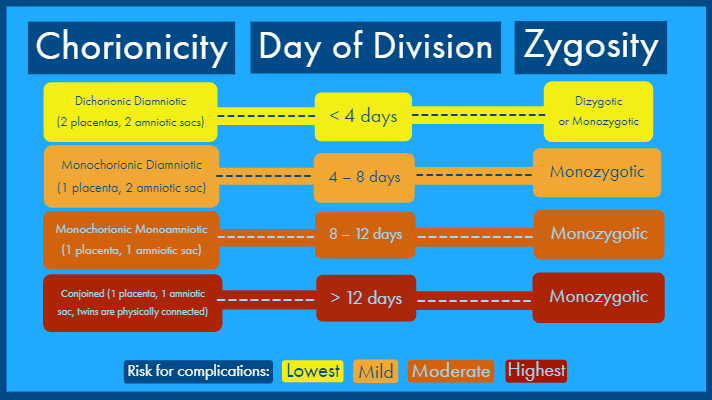




Twins: Are They Identical or Fraternal? And Why That's No Question to Roll Your Eyes At


If you’re having twins, you may be feeling excited, overwhelmed, scared or all of the above. Maybe you’re trying to prepare yourself for all the diapers, the feedings, the laundry and even the questions.
As any parent of twins might tell you, this may become one of the most common questions you get: Are they identical or fraternal?
In time, you may get tired of answering it – even roll your eyes each time you do. But as it turns out, it’s a very important question – one that your doctor will be quick to address.
Why the number of eggs, placentas and amniotic sacs matter
Medically, there are two ways we categorize twins:
- Zygosity: How many sets of genetics are present
- Chorionicity: How many placentas are present
Zygosity
When you answer the “identical or fraternal” question, you’re really answering the question of zygosity.
Most twins occur following the release of two eggs that are each fertilized. These are fraternal twins or in medical speak, dizygotic twins. Some twins occur after a single egg is fertilized, grows a bit and then separates into two embryos. These are identical twins or monozygotic.
Why does any of this matter? It all comes down to risk.
While there are risks associated with all twin pregnancies, dizygotic (fraternal) twin pregnancies usually bring about the least amount of complications, carrying the lowest risk of all types of twins.
Worse complications are possible with monozygotic (identical) twins because the embryo is dividing. This event produces three possible combinations in terms of number of placentas and amniotic sacs.
Chorionicity
To further gauge risk in twin pregnancies, we look at chorionicity – counting how many placentas and amniotic sacs are present. These numbers vary based on when a single fertilized egg divides into two embryos. This is the most important piece of information when caring for a twin pregnancy, and the best time to gather this data is in the first trimester.

Once we know how many placentas and amniotic sacs are present we can effectively gauge risk. Keep in mind: Most twins (80 percent) have two placentas and two amniotic sacs (dichorionic diamniotic), which, again, is most ideal in terms of risk.
Possible risks associated with a twin pregnancy
Because the placental anatomy is so important, it is quite common for an OB/GYN to recommend that a maternal-fetal medicine physician help care for the twin pregnancy.
Did you know? Every year the Methodist Women’s Hospital Perinatal Center helps to care for over 100 sets of twin pregnancies.
Your team will walk you through the risks unique to your pregnancy, but in general, you can expect discussions regarding:
Fetal risks
- Genetic abnormalities
- Birth defects
- Preterm birth
- Abnormal growth
- Stillbirth
Maternal risks
- Blood pressure complications
- Gestational diabetes
- Anemia
- Postpartum depression
You can also expect to discuss delivery risks (vaginal vs. cesarean).
Because a twin pregnancy carries more risk, you can also expect more ultrasounds than someone carrying just one baby. While a singleton pregnancy may only require a couple ultrasounds, this is the typical ultrasound approach for a dichorionic diamniotic twin pregnancy:
- First exam in the first trimester
- Cervical length assessment at 16 weeks
- Anatomy exams at 20 weeks
- Growth exams every four weeks to follow
- Weekly ultrasound in the third trimester
It’s important to note that your plan may vary based on your specific risk profile.
Maximizing a positive pregnancy outcome
So what can you do to ensure the healthiest pregnancy possible? Thankfully there are a few steps parents can take.
Nutrition
A twin mom will need to make a lot of extra blood to support her pregnancy. This will stress nutritional reserves, which may cause anemia.
Dietary sources of iron and folate are key to helping the babies develop. Sure, meat contains iron, but don’t ignore those leafy greens, especially broccoli and spinach. They are loaded with iron.
Because it’s often difficult to get in as much folate as you’ll need, you may consider taking a folate supplement in addition to a prenatal vitamin.
Women who are pregnant with twins should aim for 1,000 micrograms a day.
Exercise
Don’t fear activity.
An active body will help grow healthy placentas.
If your specific risks change and activity ought to be removed from your daily routine, your care team will be sure to discuss that with you.
In the meantime, get moving! It’s good for you, and it’s good for the babies.
A good and easy rule of thumb? Rest when you’re tired but move when you can.
Just be sure to consume plenty of fluids. Proper hydration is crucial during pregnancy.
Delivery
Your birth plan is important to your care team.
But when it’s time for your babies to enter the world, know that your providers will make recommendations to ensure you and your babies are safe.
Yes, twins can be delivered vaginally, but sometimes a cesarean section is necessary.
And because of the increased risk surrounding delivery, a twin birth will likely have extra hands present to help.
This can be overwhelming for parents.
Just know that everyone is there for a reason – they are not there as spectators.
So take care of yourself and take a deep breath. As a maternal-fetal medicine specialist with Methodist, I can assure you: Everything we do is designed, studied and performed with your best interest in mind.

